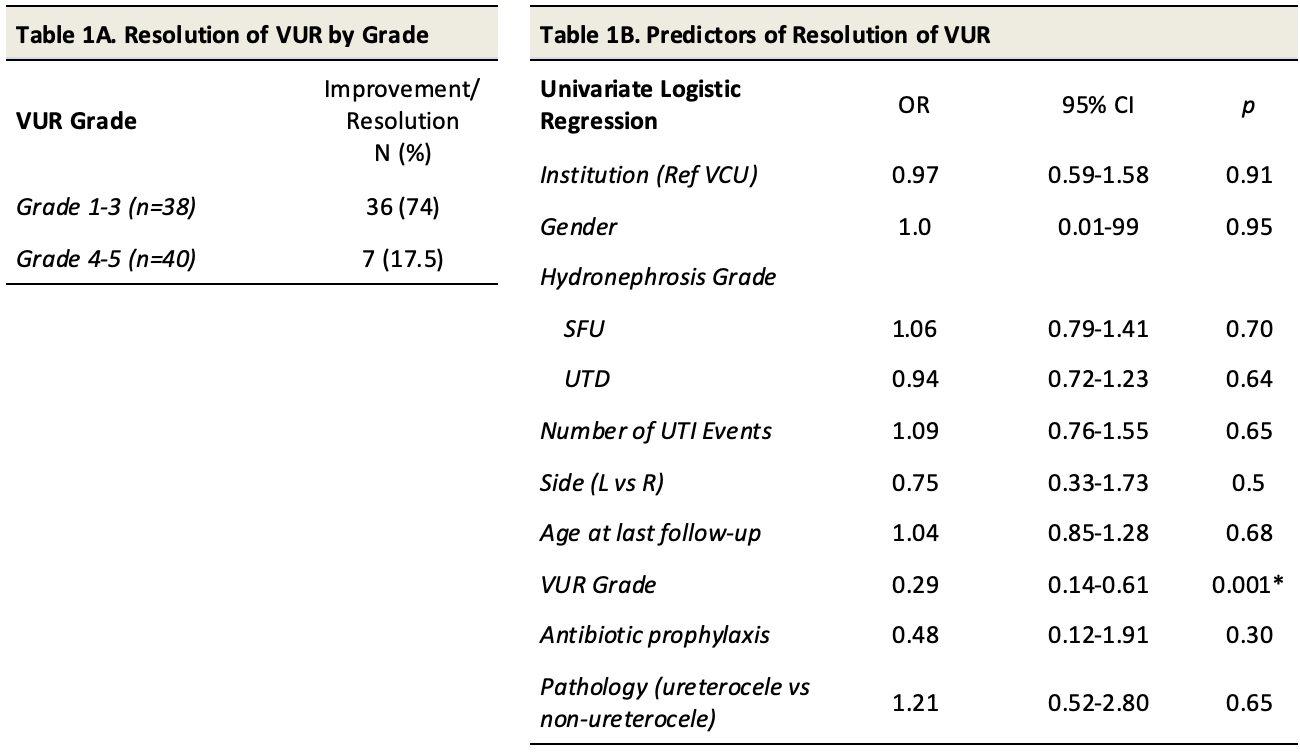Back
Poster, Podium & Video Sessions
Moderated Poster
MP17: Pediatric Urology: Upper & Lower Urinary Tract
MP17-02: Predictive Factors for Improvement/Resolution of Vesicoureteral Reflux in Duplex Kidneys
Friday, May 13, 2022
4:30 PM – 5:45 PM
Location: Room 225
Clinton Yeaman*, Kathryn Morgan, Fionna Sun, Charlottesville, VA, Sherry Ross, Jamie Michael, Chapel Hill, NC, Rebecca Zee, Richmond, VA, Hans Pohl, Daniel Casella, Bruce Sprague, Washington, DC, C.D. Anthony Herndon, Richmond, VA, Nora Kern, Charlottesville, VA
- CY
Clinton Yeaman, MD, BS
University of Virginia
Poster Presenter(s)
Introduction: Most vesicoureteral reflux (VUR) improves spontaneously over childhood with resolution rates of 45-70% in simplex kidneys. Lower pole VUR in duplex kidneys has not been as well studied with a single 1991 study citing resolution rates of 85% for grades 1-2 and 36% for grade 3 VUR. We aimed to describe the occurrence of VUR in duplex systems as well as predictive factors for resolution/improvement.
Methods: : Patients were retrospectively reviewed between 2015-2020 treated at 4 institutions in the Mid-Atlantic. Inclusion criteria included patients with a duplex kidney with any grade of lower pole VUR. Multivariate logistic regression was used to identify predictors of VUR resolution based upon demographic and clinical characteristics. Successful improvement/resolution was defined as downgrading to grade 3 VUR or lower, and failure was defined as persistent grade 4-5 VUR. Descriptive statistics and regression modeling were performed using SAS.
Results: Of a cohort of 223 patients, 93 patients (41.7%) had lower pole VUR into 98 renal units. 68 patients (75%) were female. 22 patients (24%) underwent surgical procedures for VUR in the duplex moieties. 10 renal units (10.8%) had grade 1, 10 (10.8%) had grade 2, 24 (25.8%) had grade 3, 16 (17.2%) had grade 4, and 33 (35.5%) had grade 5 VUR. Infants were diagnosed at a mean age of 6 months and underwent repeat exam at a mean age 2.8 years (SD 2). 20 patients (21.5%) did not have repeat VCUG performed. On follow-up, VUR resolved/downgraded in 43 patients (55.1%), persisted at low grade in 7 patients (8.9%) and persisted at high-grade in 28 (35%). VUR resolved in 74% of those with grades 1-3 and in 17.5% of those with grades 4-5 (Table 1A). On univariate analysis (Table 1B), the only predictive factor for resolution of VUR was VUR grade (p=0.001) and was not affected by gender, grade of hydronephrosis or upper pole pathology. On multivariate analysis, low grade VUR remained a significant predictive factor (p=0.006).
Conclusions: 55% of cases of lower pole VUR in duplex kidneys resolve spontaneously /downgrade to low grade. Spontaneous resolution seems to be affected by low grade VUR status alone. 83% of high grade VUR remained high grade at follow up.
Source of Funding: N/A

Methods: : Patients were retrospectively reviewed between 2015-2020 treated at 4 institutions in the Mid-Atlantic. Inclusion criteria included patients with a duplex kidney with any grade of lower pole VUR. Multivariate logistic regression was used to identify predictors of VUR resolution based upon demographic and clinical characteristics. Successful improvement/resolution was defined as downgrading to grade 3 VUR or lower, and failure was defined as persistent grade 4-5 VUR. Descriptive statistics and regression modeling were performed using SAS.
Results: Of a cohort of 223 patients, 93 patients (41.7%) had lower pole VUR into 98 renal units. 68 patients (75%) were female. 22 patients (24%) underwent surgical procedures for VUR in the duplex moieties. 10 renal units (10.8%) had grade 1, 10 (10.8%) had grade 2, 24 (25.8%) had grade 3, 16 (17.2%) had grade 4, and 33 (35.5%) had grade 5 VUR. Infants were diagnosed at a mean age of 6 months and underwent repeat exam at a mean age 2.8 years (SD 2). 20 patients (21.5%) did not have repeat VCUG performed. On follow-up, VUR resolved/downgraded in 43 patients (55.1%), persisted at low grade in 7 patients (8.9%) and persisted at high-grade in 28 (35%). VUR resolved in 74% of those with grades 1-3 and in 17.5% of those with grades 4-5 (Table 1A). On univariate analysis (Table 1B), the only predictive factor for resolution of VUR was VUR grade (p=0.001) and was not affected by gender, grade of hydronephrosis or upper pole pathology. On multivariate analysis, low grade VUR remained a significant predictive factor (p=0.006).
Conclusions: 55% of cases of lower pole VUR in duplex kidneys resolve spontaneously /downgrade to low grade. Spontaneous resolution seems to be affected by low grade VUR status alone. 83% of high grade VUR remained high grade at follow up.
Source of Funding: N/A


.jpg)
.jpg)